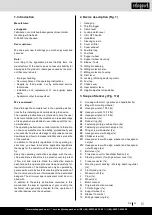
www.scheppach.com /
+(49)-08223-4002-99 /
+(49)-08223-4002-58
30
GB
9.4 Idle speed
Set throttle control lever (2) to its „
“ position to re-
duce stress on the engine when tilling is not being per-
formed. Lowering the engine speed to idle the engine will
help extend the life of the engine, as well as conserve
fuel and reduce the noise level of the machine.
9.5 Gear selection
Switching between forward and reverse:
Press the clutch lever (3) to move the power cultivator
forward. Release the clutch lever (3). Set the throttle le-
ver (2) to the „
“ position. Adjust the required gear
with the gear selection lever (22). Adjust the throttle lever
(2) to the desired speed. Grasp the two hand grips (1)
with both hands. Release the locking clutch lever (4) by
pressing it and pull the clutch lever (3) upwards.
9.6 Stop engine
Move the clutch lever (3) to the starting position to stop
the blades.
Make sure that the locking clutch lever (4) engages.
To stop the engine, set the throttle lever (2) to the „
“
position and the ON-/OFF switch (5) to position „ OFF “.
Then set the gear selector lever (22) to position „ Neutral“.
m
ATTENTION!
- With the engine is switched OFF, set
the gear selector lever to the „High“ position for safety
function as a parking brake (on slopes).
If the „OFF“ position of the ON-/ OFF switch (5) does not work,
set the choke-lever (21) to the „ “ position, to stop the engine.
Set the fuel tap (20) against to the „
“ position, to stop
the engine.
m
ATTENTION! Do not set the choke lever (21)
against the „ “ position to stop the engine. This
can damage the engine.
9.7 Operating speed
Normal operating speed:
•
Set the throttle lever (2) to “High” for best results.
Cultivation:
•
The throttle lever (2) should be adjusted to the step
speed with forward movement.
10. Working instructions
10.1 Depth regulation
Besides depth regulator rod setting, variation of pressure
on the handles also helps further control of tilling depth
and travel speed. A downward pressure on the handles
will reduce the tilling depth and increase the forward
speed. An upward pressure on the handles will increase
the working depth and reduce the forward speed.
10.2 Tiling
Tilling is digging in, turning over and breaking up gar-
den soil and preparing a seedbed for planting. Best tilling
depth is 100 mm to 150 mm. A tiller will also clear the
soil of unwanted vegetation. The decomposition of this
vegetation matter enriches the soil.
Avoid tilling soil that is too dry as it will pulverize and pro-
duce a dust that will not hold water
- Water a few days before tilling.
Also, tilling soil that is too wet will produce unsatisfactory
clods.
- Wait a day or two after heavy rain for the soil to dry.
Better growth will be obtained if an area is tilled properly and
used soon after tilling to preserve the moisture content.
The type of soil and working conditions will determine the
actual setting of the tilling depth. In some soils, the desired
depth is reached by first passing over garden. In other soils,
the desired depth is obtained by going over the garden two
or three times. In later case, the depth regulator rod should
be lowered before each succeeding pass over the garden.
Passes should be made across the length and width of the
garden alternately. Do not try to dig too deeply in the first
pass. If the machine jumps or bucks, allow the unit to move
forward at a lightly faster rate.
If the tiller stops forward motion and tries to dig in one spot,
rock the handles from side to side to start it moving forward
again.
Rocks which are turned up should be removed from the
garden area.
10.3 Cultivating
Cultivating is loosening or digging around growing plants
to disrupt weeds and aerate soil. Less than 50 mm depth
is always desirable.
11. Maintenance & Cleaning
Cleaning the machine
m
ATTENTION!
- If using compressed air to clean the ma-
chine, wear appropriate eye protection and a dust mask.
Keeping your tiller in top running condition will prolong its
life, and help you obtain optimum performance whenever
you wish to till your garden.
Cleaning blades / tools (14)
Clean the tiller underside of the milling protection hous-
ing (17) after each use. The dirt washes off tines easier if
rinsed off immediately instead of after it dries.
1. Turn off engine. Engine must be cool.
2.
The ON-/OFF switch (5) to position „ OFF “ and discon-
nect the ignition cable (18a) from the spark plug (18c).
3. Remove all vegetation, string, wire, and other materi-
als that may have accumulated to the axle between
the inside set of tines and the seal on the transmission
housing.
Checking the clutch
As clutch wears out, the same lever could have a wider
opening, being so uneasy to use. This means that it
is necessary to adjust the cable, setting clutch lever
on its original position acting on the adjustment device
and on counternut.
4.
Always towel dry the tiller afterwards and apply a light
coat of oil or silicone to prevent rusting or water damage.
5. Replace spark plug wire.
















































